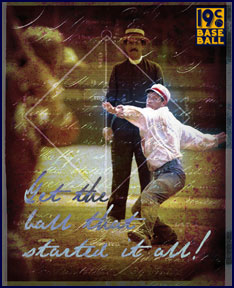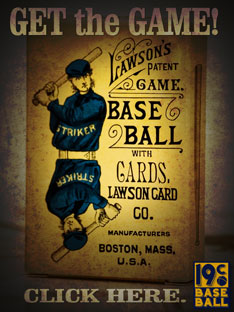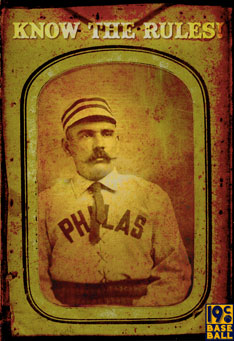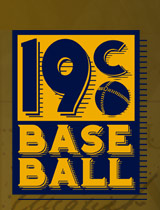Advancing on Foul and Fair Batted Balls
By Eric Miklich

dvancing a base runner was a very important part of a 19th century base ball match. Unlike the game that is played today the home run was not nearly as common and not relied upon to score runs. Because the baseballs that were used did not become mass produced until the mid-1860's and not standardized in the National League until 1878, the "action" of the ball was inconsistent. This forced the batters to hit ground balls and line drives as opposed to long fly balls. The early 19th century game consisted mainly of singles and stolen bases.
Knickerbocker Rules
The original "20 Rules," formulated by the Knickerbocker Club in 1845, listed in rule number 18 the following;
"No ace or base can be made on a foul strike."
This rule referenced a foul batted ball. The term "foul strike" was not used again until 1869 by the National Association of Base-Ball Players and its meaning was not the same as written in the 1845 Knickerbocker rules.
There was no mention if base runners could advance on a fair batted ball caught on the fly or first bound. Rule number 12 of the original 20 rules stated;
"A ball being struck or tipped and caught either flying or on the first bound is a hand out."
With in a few years the Knickerbockers favored the "fly" game, retiring the striker only when a batted ball is caught before touching the ground and even challenged local clubs to play "fly game" matches.
1854 Update
The 1854 rules were "updated and modified" at a meeting between the Knickerbocker, Gotham and Eagle clubs, all from New York. A slight change to the wording of the rule, which was rule number 14, was made. It stated;
"No ace or base can be made on a foul stroke."
This more clearly defined the foul ball rule.
The possibility of advancing on fair batted balls caught on the fly or the first bound was still not addressed.
The First Base Ball Convention
The first baseball convention held in New York on February 15th, 1857, was a monumental meeting. The rules of the game were discussed, updated, modified and broadened. The rule pertaining to a foul batted ball, as well as a fair batted ball, were covered in Section 16 and were as follows,
"No ace or base can be made upon a foul ball, nor when a fair ball has been caught without having touched the ground; and the ball shall, in both instances, be considered dead and not in play, until it shall first have been settled in the hands of the pitcher. When a fair ball has been caught without having touched the ground, the players running the bases shall have the privilege of returning to them."
Although the wording changed, still no base runner was allowed to advance on a foul batted ball. There was no rule stating if the base runners were allowed to be put out on a foul batted ball while returning to his original base. If no out was able to be made in this way, the base runners had a tremendous advantage and could run on every batted ball without the penalty of being put out. It may be concluded, although not stated, that once the ball is held by the pitcher, in any part of the field, the play begins and runners attempting to advance on foul batted balls were allowed to be put out. This would perhaps explain the reference of the play being "dead" until the ball was returned to the pitcher.
Base runners were now empowered to advance on a fair batted ball that was caught on the first bound. During this convention the Knickerbocker Club had proposed that a batter was to be put out if a fair batted ball was caught on the fly only. This rule was not accepted because the delegates felt that this likened the game too closely to Cricket and it would cause injury the player's hands. However, a concession was made that if a fair batted ball was taken on the fly no base runner was allowed to advance.
The National Association of Base-Ball Players
The base running rule was modified at the 1858 convention and explained how to put a runner out on a foul batted ball. It stated;
Section 16. Running on fair and foul balls. No ace or base can be made upon a foul ball, nor when a fair ball has been caught without touching the ground; and the ball shall, in both instances, be considered dead and not in play until it shall first have been settled in the hands of the pitcher; in either case the players running the bases shall return to them, and shall not be put out in so running unless the ball has been first pitched to the striker.
In 1858, returning the ball to the pitcher in the above scenarios as quickly as possible was very important, however, delivering the ball to the batter certainly gave the base runner ample time to return to his original base. This rule removed the advantage all base runners had of running whenever the ball was struck. If runners were allowed to be put out foul batted balls while returning to their original base in 1857, this rule may have been instituted because of the ease of retiring base runners.
If the runners attempted to advance on a fair batted ball that was caught on the fly they were now at liberty to be put out.
What was not defined was how too retired the base runners. Did they have to be tagged by a defensive player holding the ball or did the base they started from simply have to be touched by the defensive player with the ball.
1860
The 1860 rules modified at the third annual NABBP convention were refined further and the rule was very clear on putting out a base runner who attempted to advance on a foul batted ball and the restrictions were relaxed. The rule appeared as follows in Beadle's Dime Base-Ball Player;
"Sec. 16. No ace nor base can be made upon a foul ball, nor when a fair ball has been caught without having touched the ground, and the ball shall, in the former instance, be considered dead, and not in play until it shall first have been settled in the hands of the pitcher; in either case the players running the bases shall return to them, and may be put out in so returning in the same manner as the striker when running to the first base."
There was no change to the 1858 rule regarding fair batted balls.
The Rules: Advancing on Foul and Fair Batted Balls Continued ![]()
The Rules of the Game: A Compilation of the Rules of Baseball 1845–1900 ![]()




